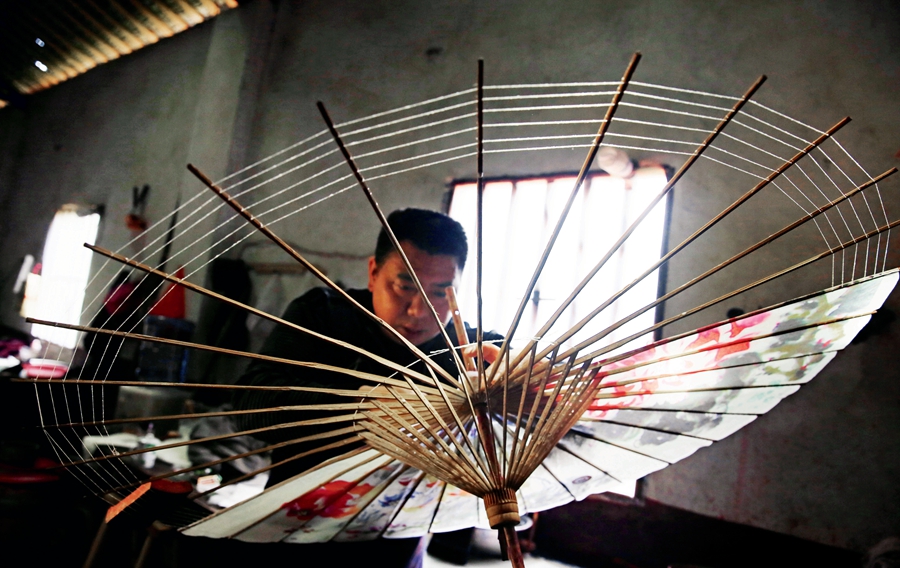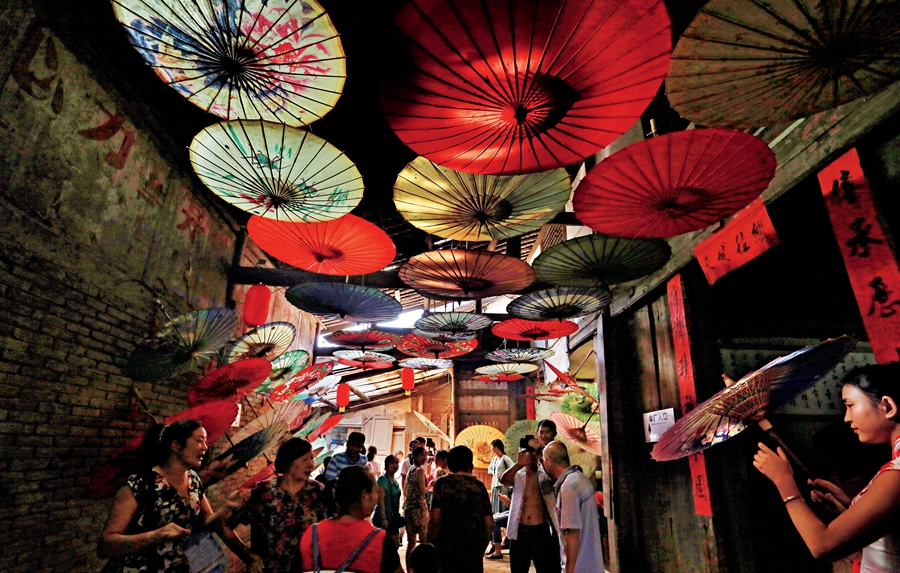Oil-Paper Umbrella: Artwork and Accessory
China Today,May 28, 2018 Adjust font size:
Culture of the Oil-Paper Umbrella
The oil-paper umbrella has been an important symbol in traditional Chinese culture. The best-known story about the umbrella is the Legend of the White Snake, in which the main characters, namely Xu Xian and Bai Suzhen (a white snake nymph), become known to each other due to an oil-paper umbrella (Xu lent his umbrella to Bai when it was raining) and they gradually fell in love and were eventually married. Therefore, in Chinese literature, the oil-paper umbrella is often related to love stories. A typical picture about the areas south of the Yangtze River depicts a young man, a young woman, or a young couple holding an oil-paper umbrella meandering along a winding alley in drizzling rain, with houses of white walls and dark grey tiles standing on both sides.

Gluing the paper cover onto the skeleton requires a sophisticated technique, which is usually done by experienced craftsmen.
Because “oil” (in Chinese it pronounced as you) and “have” are homonyms, and “paper” and “child” are similar in pronounciation; also, as the character 伞 (umbrella) in original complex form contains “five people,” the oil-paper umbrella symbolizes a blessing for the family to have many children and grandchildren. The umbrella opens into a round shape, symbolizing a happy and complete life, so it is customary to include an oil-paper umbrella into dowries to the bride and such custom has been widely adopted in Hakka marriages in places such as Taiwan and some Southeast Asian countries.
In addition, the oil-paper umbrella also symbolizes romantic and faithful love. In the area inhabited by the Yao people, the umbrella has been used as an engagement present by the groom’s side. First the man proposes a marriage in the woman’s house. After acquiring the permission of the bride’s parents, he needs to send a representative to take a red oil-paper umbrella to the woman’s house and place it on the table above of which there is a shrine for ancestral tablets. If the bride is willing to marry him, she would take the umbrella from the table personally and stitch the umbrella with 12 triangle cotton decorations. The representative of the man’s family should bring the umbrella back as the proof of a successful engagement. If a divorce is made later, the husband must return the stitched triangle decorations back to the wife.
In the past, it was also a tradition for people who would travel far to take the imperial examinations to bring a red oil-paper umbrella in their backpack, so it is called Baofu (meaning backpack) umbrella. As “backpack” and “giving blessing” are homonyms in Chinese, bringing an oil-paper umbrella symbolizes the blessings for a safe journey and bright future for the candidate. People believe the red tung oil can ward off calamities, avoid evil spirits, and ensure safety. Today, some families in southeast coastal areas still hang the oil-paper umbrella on roof beam as a guardian of the house. The oil-paper umbrella is also widely used in ceremonies honoring ancestors. Because the emperors in ancient China were often under a big yellow umbrella when they went out of the palace, showing their supreme status, people use oil-paper umbrella to honor their ancestors in the hope that the deceased family members could enjoy an affluent life and a quick rebirth.
Although the red oil-paper umbrella is no longer a commonly used device for rainy days, it has never disappeared from people’s lives. Many places around China still keep the tradition of gifting a red oil-paper umbrella in celebration for birthdays, weddings, newborns, moving houses, and promotions at work.

